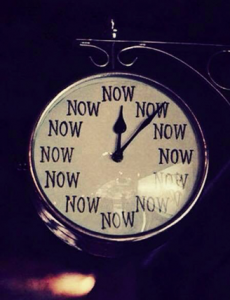 These past few weeks, I have been grappling with a kind of spiritual awareness which continues to unearth and challenge the way I perceive life. I find myself reflecting on the way I think and feel, and also upon the actions I do or don’t do.
These past few weeks, I have been grappling with a kind of spiritual awareness which continues to unearth and challenge the way I perceive life. I find myself reflecting on the way I think and feel, and also upon the actions I do or don’t do.
In wanting to explore this new era of enlightenment, I took Eckhart Tolle’s book, The Power of Now off my shelf. Its content is unwaveringly dense, often leaving me exhausted by concepts too thick to conquer. Though the pages have barely been touched, the title, “The Power of Now” remains ever present to me: challenging me, questioning me, and inspiring me.
Life lived NOW means being present to the opportunity of this moment in time. This moment is the opportunity to experience exactly what is happening, and not what I/we should or could be doing…nor the eight tasks work expects done simultaneously and seamlessly. On the other hand, the familiar sentiment, life lived “Someday, One Day” clouds being present to the gifts of now. A “Someday, One Day” attitude often creates log jams and stagnation in our physical, emotional, and spiritual space. Procrastination goes hand-in-hand with life lived from a “Someday, One Day” perspective.
Being present to NOW fosters gratitude, calmness, peace and stillness…much like the breath we are asked to be present to in our meditation or yoga practices. And in this state of NOW, life flows. Action is second-nature; it is real, purposeful, and natural. It is not sabotaged by “Someday, One Day’s” indecisions, doubts and postponements. Lightness, awakenings, and insights are encouraged by the presence of “NOW” thinking. Fear of change, the unknown, or something different, keeps the “Someday, One Day” card in our hip pocket ready to be played when life feels uncomfortable.
Eckhardt Tolle said, “Some changes look negative on the surface but you will soon realize that space is being created in our life for something new to emerge.” I see this played out time and time again in my own life and in the lives of my clients. Taking on “Someday, One Day’s” mantra of “later, later, later” and actually getting started now creates oceans of energy. Physical spaces are transformed uncorking the damned up to-do’s, intentions, goals and aspirations allowing life’s energies to flow again. Frequently, at the end of a session, clients feel lighter, freed up and elated as the stagnate piles and clutter dissolve into organizational bliss.
Eunice S. Carpitella, Executive Coach & Leadership Development Consultant of Transformative Dynamics, said, “LATER” is the enemy to living a fulfilled, satisfying and rewarding life. It’s always convincing you that whatever needs to be done will somehow be improved by waiting.”
Werner Erhard lightened up this dilemma for me saying, “Thinking about ‘it’ leaves you with more thoughts and older.”
Life is passing by and with it, those precious moments of NOW’s gifts. Moments are accumulating into days, months and even years. We yearn to live our dreams, not the reasons why not. “Someday, One Day” is the status quo and “later, later, later” its hypnotic song. Overcoming “later’s” mantra takes motivation, drive, a push, and support fuelled by a vision to let go of “Someday, One Day.”
Bringing order to chaos and freedom and ease to life is what Professional Organizers love to do. Call an organizer when you need a gentle nudge, a kick start, a fresh set of eyes or a partner to drive away the “Someday, One Day” blues.
Cause a life you love, lived joyously in the presence of NOW — moment by moment.
Embrace The Power of NOW!
Let me be the first to wish you Happy National Get Organized Month! I saw a sign hanging in Lowe’s that said “Resolve to Declutter” and it was surrounded by a colorful array of storage containers. It’s that time of year when many of us look around our homes and ask “Where did all this stuff come from?” Taking the first step and staying organized can be daunting, but if you think you are alone, you are not. Here are ten barriers that keep my clients from starting and staying organized. Let’s break it down:
If you or someone you love needs help moving forward in the New Year, don’t hesitate to get in touch with a professional: a cleaning service, a senior care agency, financial planner, insurance broker, senior move management company, or a professional organizer. Professionals are trained to listen and narrow in on your specific needs. They can give you a jump start or much needed tools to help you or someone you love live their best life.
Clutter Quote: “As a single footstep will not make a path on the earth, so a single thought will not make a pathway in the mind. To make a deep physical path, we walk again and again. To make a deep mental path, we must think over and over the kind of thoughts we wish to dominate our lives.” Henry David Thoreau
 While visiting Italy I learned the maxim, Americans Live to Work, while Italians Work to Live. Their work day seemed a little longer, but the pace appeared less frenetic. They started a little later but enjoyed leisurely lunches and animated banter with coworkers.
While visiting Italy I learned the maxim, Americans Live to Work, while Italians Work to Live. Their work day seemed a little longer, but the pace appeared less frenetic. They started a little later but enjoyed leisurely lunches and animated banter with coworkers.
Sitting in cafes observing the Italian lifestyle was as interesting as taking in their architecture. They appeared to savor the moment, dining alfresco, without waiting for the weekend to jam chores and fun into forty-eight hours. I admired this philosophy and tried to integrate it into my life upon return.
I became more aware of certain turns of phrase here in the States. Sentences such as, “I have to Chair the fundraiser again this year,” now had a different ring to them. When someone said, “I have so many events and obligations, but I can’t eliminate any of them,” it somehow sounded different.
Many of us approach work with the same mentality. Is there something about our culture that equates being busy with a badge on honor? Are we concerned about appearing lazy if our schedules are less than hectic? I’ll admit to needing to learn to say no. It’s not easy.
How does this relate back to time management? Simply stated, the way we use our time can often be a manifestation of our beliefs.
If we believe that anything less than busy is unambitious, our calendars will be filled accordingly. If we want a life that reflects our goals and dreams, decisions should be made mindfully before the calendar fills up.
In terms of time management, often the goal is to try to fit more tasks into our life. I lean toward minimalism in my organizing practice, and I believe the same minimizing principals can help us with time management. Yes, we need to plan work, meetings, errands, and time with friends and family. The idea here is to step back and do all this mindfully. Start with your goals or the goals of your family. We can work and give back, but we can do so joyfully. Here are some points to remember:
Business and pleasure don’t need to be separate. As long as you conduct yourself with appropriate decorum, work can be fun too. Live in the moment. Strive to be present. It certainly seems to work in Italy.
 Believe it or not, it only takes a few steps to get your online files organized. Below are seven steps to help you save countless hours and avoid those embarrassing situations that come from searching for lost files. Let’s get started!
Believe it or not, it only takes a few steps to get your online files organized. Below are seven steps to help you save countless hours and avoid those embarrassing situations that come from searching for lost files. Let’s get started!
1. Start at the Root
Determine where you want your file system to live on your computer. Having all your files and documents under one ‘root’ folder on your computer will make it easy to locate your files. Many single Windows users have all their folders, files, and documents stored haphazardly in the ‘Documents’ or ‘My Documents’ folder on their PC. If this sounds like your system, then you might want to consider starting from scratch. The easiest way to do this is to save all your current folders, files, and documents to a new folder and name it something like Archive_2015 or any appropriate name that’s easy to remember. Now you can start to create a new file structure with broad categories without losing any of your current information. After your new filing system is created, you can move previously created files and documents to the newly created system on an as needed basis.
2. Create a File Structure
File structure is the backbone of your filing system and it begins with using folders for general categories. Think big when creating filing categories and limit the number of folders to a critical few. Describe the contents of the folders with short commonly used, meaningful terms. Start broad and get more specific as you add files and documents to those broad category folders.
Examples for business folder names:
Administration
Clients
Financial
Insurance
Legal
Marketing
Organizations
Sales
Vendors
Projects
Examples for personal folder names:
Financial
Medical
Health & Wellness
Housing
Insurance
Taxes
3. Use Sub-Categories
After you have created your folders using broad categories, you will want to create files with sub-categories. Sub-categories are used to organized those files and documents within your folders. You may have a folder called ‘Projects’ and within that folder are several files or sub-categories called Project-A, Project-B and Project–C.
4. Determine a Naming Convention
It’s important to name your folders and files consistently and logically. Storing multiple drafts of the same document can get confusing, and a naming convention is one way to avoid that confusion. Also, adding a date at the end of the file name is a great way to keep track of multiple documents, and the addition of initials at the end of the file name will add clarity if more than one person is working on the same document.
Naming convention examples:
Jane_Doe
Jane_Doe_1/1/15
Jane_Doe_1/1/15_JD
5. ‘Save As’ You Go
File your documents in the proper location by using the ‘Save As’ feature. ‘Save As’ allows you to save and file your documents as you go, so they will be placed in the correct file or folder from the start.
6. Clean Up Your Desk Top
Evaluate what you really use and delete those icons or shortcuts that are outdated or infrequently used. Note: deleting a shortcut is not the same as deleting a file, folder or program from your computer. Deleting the shortcut will simply remove it from your desktop. A program like Fences is a great way to automatically sort out all those remaining icons into organized, easy to see boxes and categories. The program can sort the categories for you or you can create your own categories.
7. Backup Your Files
Have a regiment in place to regularly back up your files. If your hard drive fails or is damaged and your only source of backup is your computer, then you risk losing all of your business transactions and correspondence. The rule of thumb for data protection is “if you need it to run your business, then back it up.” Having all your files saved to a ‘root’ will make that process easy.
Everyone has a different threshold for what it takes to go from manageable to maniacally crazed. In honor of National Clean Out Your Computer Day, celebrated the second Monday in February, I offer advice on four hot spots for digital clutter:
My advice: focus your efforts on one of the four electronic clutter hot spots OR do a little purging in each category to get yourself calm and collected — literally.
When you approach winnowing your documents, photos, desktop or email, get ready for a trip down memory lane. You will be reminded of things you’ve completely forgotten — and some should remain forever forgotten, but some should be resurrected…or completed. It’s helpful to have a notepad next to you to jot down the name of a particular file that you want to compare to others and select the best version. You may want to start a to-do list for future decluttering projects. Clearing out your computer can get addictive…
EMAIL: Without getting into specifics about which apps work best on which platforms, the principles of email management are consistent:
YOUR DESKTOP: Go for Zen on your desktop and completely clear it! Apart from straining your computer to refresh icons continually, desktops are there to provide the calm visual space your brain craves while processing data. While your desktop may seem like an infinite holding basket for what’s important at the moment, or a safe place to store what might get lost, left unchecked it will become a graveyard of expired photos, files, and reminders. A final caution: desktop items are typically not included in routine back-ups.
PHOTO MANAGEMENT: When there is no monetary cost involved in taking photos there is little motivation to weed out bad shots and duplicates: except photos take up a LOT of memory. So rather than pay for upgrades, take a look at your stockpile of digital pics and decide on your keepers. Trash the rest. Do not attempt to manage your photos in a day; a few hours a week is a good goal until you have controlled your collection to date, and then a half-hour a week to maintain going forward. If that seems too daunting…just deal with the photos from January 1, 2015 and tackle your larger collection with a pro.
DOCUMENTS: The two biggest categories to tackle are:
YOU have to decide what maintenance schedule will work for your lifestyle…but National Clean Out Your Computer Day aside, once a year is not enough.
Let me be the first to wish you Happy National Get Organized Month! I saw a sign hanging in Lowe’s that said “Resolve to Declutter” and it was surrounded by a colorful array of storage containers. It’s that time of year when many of us look around our homes and ask “Where did all this stuff come from?” Taking the first step and staying organized can be daunting, but if you think you are alone, you are not. Here are ten barriers that keep my clients from starting and staying organized. Let’s break it down:
If you or someone you love needs help moving forward in the New Year, don’t hesitate to get in touch with a professional: a cleaning service, a senior care agency, financial planner, insurance broker, senior move management company, or a professional organizer. Professionals are trained to listen and narrow in on your specific needs. They can give you a jump start or much needed tools to help you or someone you love live their best life.
Clutter Quote: “As a single footstep will not make a path on the earth, so a single thought will not make a pathway in the mind. To make a deep physical path, we walk again and again. To make a deep mental path, we must think over and over the kind of thoughts we wish to dominate our lives.” Henry David Thoreau